
Syndication Fees – Is the Tail Wagging the Dog?
Written by David Thompson
I struggled with the title of this blog because as with any good vetting of a syndication deal fees should be reviewed and are important to understand. That said, I see a few investors get so wrapped up in fees that if they start the conversation about fees and if on a second follow up that is the lead concern they still have then I’m thinking that the tail is wagging the dog and usually move to explain we may not be the right fit for each other.
Now, I do like educating folks and it’s important if this is an area you want to know about and should know about it but if it causes you angst and that is the reason you may not do a deal then syndication from a limited partner / investor standpoint is probably not for you. You may be more of a do it yourself person who has a mental block on any fees regardless. But paying fees are for work you don’t want to do and expect good performance from others for giving up this control. You just must decide if that is worth it to you. For me, if I’m looking at returns of say 6% and I’m getting hit with 2% charges, so my post return may be 4%, then as a percentage it’s a big deal. However, with most common apartment syndications as of this writing producing 8% -10% cash on cash returns and a return of investment in the 16% to 20% annualized upon sale (post fees), I don’t usually get much heartache from investors.
I used to have some of that “no fee” mentality. I am a big proponent of no load, index funds for a portion of my portfolio as an example when I just want broad exposure to an asset class and don’t see the manager able to add much value since they are just tracking an index. But when it comes to value add syndication, there is a ton of work involved in finding the deal, negotiating, due diligence, raising the capital, financing, renovation, repositioning, rebranding, stabilizing and final sale. If a limited partner (the investor) essentially just invests in the deal and can be passive, then there needs to be compensation for the sponsor to do all this work. It’s a team game and often there is a team to compensate for end to end execution.
Now, there are fees and equity splits that need an explanation. Fees should be sufficient to help keep the lights on, pay the team to support the deal from end to end over a typical 5-year hold. I would argue that without fees, if the project earns only an 8% preferred return for the investor over the life of the project, certainly well below the 16% – 20% return on investment expected in most of the deals I review, the sponsor would not make any money and would lose money on the project. Hence, fees are an important component of the GPs (General Partner) compensation but should be a smaller portion, say 25% of the overall compensation.
The two most common and meaningful fees are the acquisition fee (1-3% of the purchase price paid once at closing) and the asset management fee (1-3% paid out typically quarterly based on revenues). The other common one I see is a loan guarantee fee, but this should be minor maybe .5% of the loan amount paid at closing to the key principals and / or wealthy third party that puts up their net worth to equal the loan amount and must have a certain liquidity. If there are other fees you should probably question them and understand if it makes sense to you.
On a side note, if you are wealthy and you know the syndicate partners well (trusting relationship) it would be an attractive investment to guarantee non-recourse loans. Why? Well, you put up no money, get a piece of the deal say 3% and the only way you would have to step in to support “guarantee” the loan is if the partners committed fraud or willingly did not pay the loan. So, if the business simply can’t pay the loan due to operational challenges that does not make the loan a recourse loan, so little risk that the bank can come after your assets as long as you know the partners well. A smart wealthy person might even demand a side agreement that even if he guarantees the loan, if the GP commits fraud, the GP owes him.
Equity splits should be a much more important part of the sponsor’s compensation (say 75% to 80%) and should be medium and mostly back end loaded, tied to performance (capital events like refinances or sales that return investor capital due to value creation). From an alignment perspective, the limited partner should be getting more of the returns early in the investment. Hence, preferred returns are an example of putting the limited partner first in order of payouts of distributions and capital events.
When I first started in the syndication business, I quickly realized that sponsors target a certain return for their investor base. Typically, an 8% preferred return is offered to investors (a return paid to the limited partners) before the GP/ sponsor gets a share, not a guarantee but the next best thing. After 8%, then some split say 70/30 (LP/GP) above the preferred return to hit a certain IRR on the project say
18%. The project may have a target earn potential of 25% before fees and splits. So, an experienced sponsor will have discretion on whether to pay a preferred return, what split makes sense and if there is to be a waterfall. A waterfall is when a certain hurdle is met say 18%, then the GP will change the split to 50/50 for every $1 earned above the 18% threshold. Although I like to see syndicates not get too carried away with hurdles / waterfalls, I certainly think if the project is hitting it out of the park that one waterfall hurdle could make sense. It does not cap the amount an investor can earn just further incentivizes the GP to exceed expectations.
All this language (preferred returns, splits, waterfalls and fees) are embedded in the Private Placement Memorandum (PPM) that is required by SEC regulations to be shared with the investor. It’s often under a section called “sponsor fees or compensation”. It’s important to review these and understand industry averages. Talk with the sponsor if you have any questions to ensure you understand and look for alignment of interests. A good sponsor will want to explain the fees if you have questions and will show returns after fees, splits and waterfalls so that the investor can get a true picture of what to expect. The returns often are still very attractive for the average investor and that is where I like to keep their focus on the big picture.
